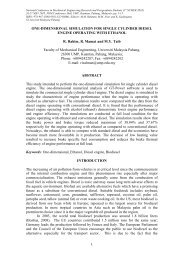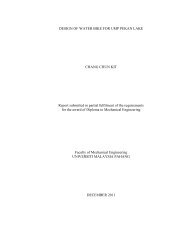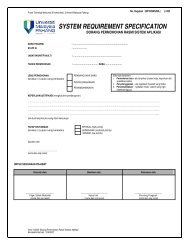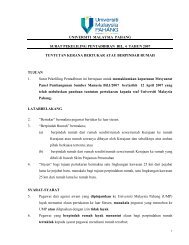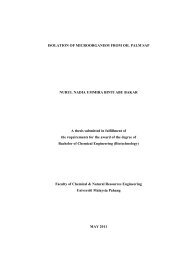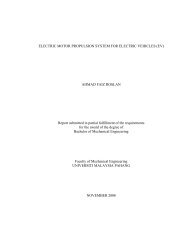implementation of quality tools in small medium industry - Universiti ...
implementation of quality tools in small medium industry - Universiti ...
implementation of quality tools in small medium industry - Universiti ...
You also want an ePaper? Increase the reach of your titles
YUMPU automatically turns print PDFs into web optimized ePapers that Google loves.
52.2 Seven basic <strong>quality</strong> <strong>tools</strong>Once the basic problem-solv<strong>in</strong>g or <strong>quality</strong> improvement process isunderstood, the addition <strong>of</strong> <strong>quality</strong> <strong>tools</strong> can make the process proceed more quicklyand systematically. Seven simple <strong>tools</strong> can be used by any pr<strong>of</strong>essional to ease the<strong>quality</strong> improvement process: flowcharts, check sheets, Pareto diagrams, cause andeffect diagrams, histograms, scatter diagrams, and control charts. (Some booksdescribe a graph <strong>in</strong>stead <strong>of</strong> a flowchart as one <strong>of</strong> the seven <strong>tools</strong>).The concept beh<strong>in</strong>d the seven basic <strong>tools</strong> came from Kaoru Ishikawa, arenowned <strong>quality</strong> expert from Japan. Accord<strong>in</strong>g to Ishikawa, 95% <strong>of</strong> <strong>quality</strong>-relatedproblems can be resolved with these basic <strong>tools</strong>. The key to successful problemresolution is the ability to identify the problem, use the appropriate <strong>tools</strong> based on thenature <strong>of</strong> the problem, and communicate the solution quickly to others.Inexperienced personnel might do best by start<strong>in</strong>g with the Pareto chart and the causeand effect diagram before tackl<strong>in</strong>g the use <strong>of</strong> the other <strong>tools</strong>. Those two <strong>tools</strong> areused most widely by <strong>quality</strong> improvement teams. [Gitlow, Oppenheim, Lev<strong>in</strong>e,2005]2.2.1 Check sheetCheck sheets help organize data by category. They show how many timeseach particular value occurs, and their <strong>in</strong>formation is <strong>in</strong>creas<strong>in</strong>gly helpful as moredata are collected. More than 50 observations should be available to be charted forthis tool to be really useful. Check sheets m<strong>in</strong>imize clerical work s<strong>in</strong>ce the operatormerely adds a mark to the tally on the prepared sheet rather than writ<strong>in</strong>g out a figure(Figure 2.1). By show<strong>in</strong>g the frequency <strong>of</strong> a particular defect (e.g., <strong>in</strong> a molded part)and how <strong>of</strong>ten it occurs <strong>in</strong> a specific location, check sheets help operators spotproblems. The check sheet example shows a list <strong>of</strong> molded part defects on aproduction l<strong>in</strong>e cover<strong>in</strong>g a week's time. One can easily see where to set prioritiesbased on results shown on this check sheet. Assum<strong>in</strong>g the production flow is thesame on each day, the part with the largest number <strong>of</strong> defects carries the highestpriority for correction.




